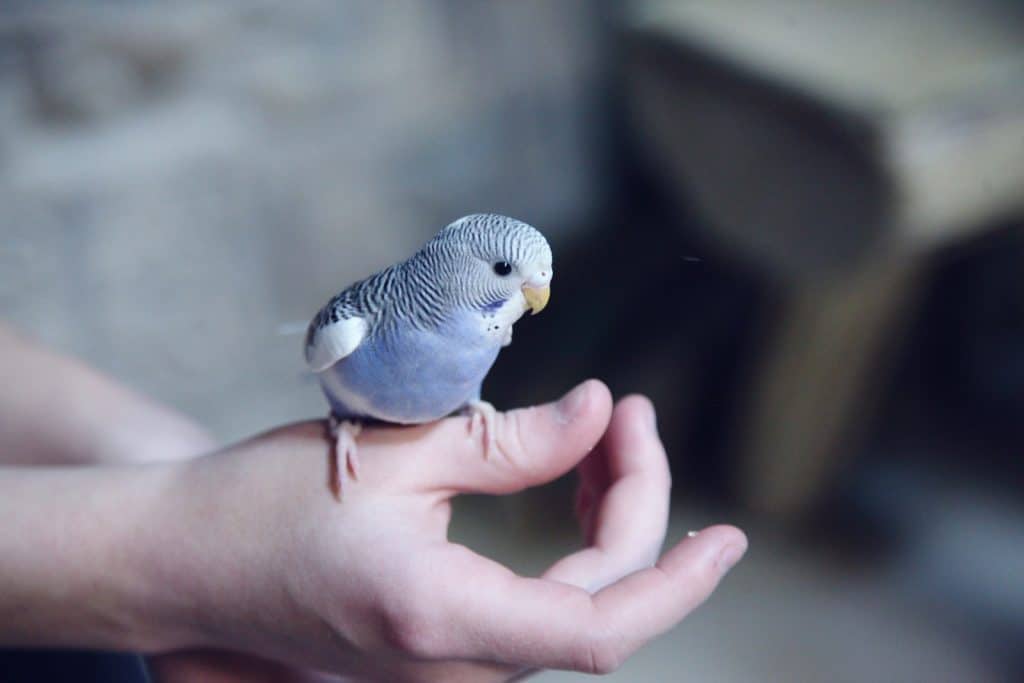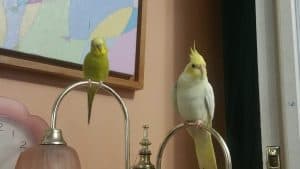Choosing between budgies and cockatiels can be challenging, as both these birds are popular pet bird species known for their unique characteristics. Let’s delve into the differences and similarities to help you decide which bird might be the perfect companion for you and your family.
Budgie vs cockatiel: Similarities
Budgies and cockatiels, both parrots native to Australia, share several similarities. They are social creatures that thrive on human interaction and make wonderful companions for bird enthusiasts. These birds are generally easier to tame compared to some other bird species, making them great pets for families with children or seniors looking for lively company.
Key Similarities Include:
- Noise Levels: Both budgies and cockatiels are relatively quiet for parrots, making them suitable for apartment living. They can mimic sounds and whistle tunes, although budgies are often more vocal, filling the room with their chatter.
- Color Varieties: Breeders have developed various color mutations in both species, enhancing their aesthetic appeal as pets.
- Intelligence and Training: They are intelligent birds that can be trained to mimic sounds and perform tricks, delighting family members with their antics.
- Social Needs: Both species thrive on social interaction and benefit from spending time with their human companions. They can form strong bonds with their owners, enjoying head scratches and cuddles.
- Talking abilities. Budgies can learn to imitate sounds and whistles, but talking budgies have a larger vocabulary than speaking cockatiels.
Cockatiels and budgies are frequently confused. Because they’re so common, people mistake them for throwaway pets or easy pets who just need a small cage and some seed to thrive. But these birds require more than that. They need a lot of attention and care, just like any other pet.
Unfortunately, literature frequently classifies cockatiels (N hollandicus) and budgies as “beginner birds”—birds for individuals to acquire their first, so that they may learn enough about living with psittacines. It is assumed that the individuals will subsequently advance to obtain a “real parrot. This attitude is a great disservice. (…)
Wilson, 1996: The appropriate bird for the appropriate owner
Budgie vs cockatiel: Differences
Cockatiels and budgies are similar in many ways, but there are also significant differences. It’s critical to think about both before making a decision and choosing the bird that’s right for you.
Psittacology is the home of both budgies and cockatiels. Both species are lively, full of personality, and add their own unique flavor to the house. However, they do so in significantly distinct ways, and here are a number of the reasons why.
- Size and Appearance: Cockatiels are larger than budgies, with distinctive yellow or white wing patches and long tail feathers. Budgies, also known as parakeets, are smaller and more agile flyers, often darting around their cage bars with energy.
- Cage size. A cockatiel cage will thus need to be larger than a budgie cage in most cases. In any case, both birds require adequate area to extend their wings and plenty of out-of-cage time.
- Noise Levels: While both birds are capable of vocalizing, cockatiels are known for their louder, more varied calls, which they use to communicate with their flock or when seeking attention.
- Temperament: Cockatiels tend to be more laid-back and enjoy sitting on their owner’s shoulder while watching TV or relaxing. Budgies, on the other hand, are energetic and curious, constantly exploring their environment and playing with toys.
- Activity level. Budgies are notorious firecrackers. They go flying all over the place at Psittacology, taking off unexpectedly and scaring the cockatiels in the process. Cockatiels are a little more subdued.
- Cuddliness. Although some budgies enjoy head scratches, they aren’t as cuddly as cockatiels. A budgie will generally prefer to sit on you and do nothing else, but many ‘tils love a good long scritch session.
- Biting. Cockatiels are known for being feisty. If we can call it that, they’re a little sassier than your average budgie. They enjoy their neck scratches but can also be irritable, sometimes screaming and giving you a warning nip for no apparent reason.
- Egg Laying: Female cockatiels have a tendency to lay eggs, even without a male present, which can be surprising for owners unfamiliar with this behavior. Budgies may also lay eggs, but it’s less common in single-bird households.
- Health Considerations: Cockatiels, being part of the cockatoo family, have a powdery down feather layer that can trigger allergies in some people. This is not an issue with budgies, making them a better choice for allergy-sensitive households.
Did you know? An English budgie may be an excellent compromise if you’re searching for something in between. They are larger and tend to be more serene than wild-type budgies. However, they are more expensive and prone to health issues.
Who is a budgie better for?
In the end, it all boils down to your bird’s activity levels. A budgie is ideal for people who want to add life and chatter to their home but don’t mind that they will not be able to cuddle with their bird. Cockatiels are ideal for individuals who need a more laid-back pet, but still want to have that unique bond that comes with having a chatty, smart bird.
The best owners of budgies are those who want an active companion who will not require too much attention and can be left alone most of the time. They must enjoy the company of others in the family. Cockatiels are best for those who want a bird that is interactive, playful, and loves to be around people. These birds do not like to be left alone for long periods of time.
Budgies are suggested for children and cockatiels for the elderly, but I’m not sure if I agree. A pair of budgies would make a wonderful companion for an older person, as they constantly keep you on your toes with their antics. And children love the high-energy nature of budgies.
Who is a cockatiel better for?
If you’re searching for a more chilled-out bird that will sit fluffed up and happy on your knee the whole time in a film, you’ll probably want a cockatiel. Sure, these birds may be noisy and fly about from time to time, but they aren’t as high-energy as a budgie.
Because cockatiels tend to have a slightly shorter fuse than budgies, they might not make the ideal pet for children.
Cockatiels are also better for those who want a bird that is friendly, playful and able to form a strong bond with their human companions. Budgies can be lovable too, but they can be independent and prefer to stick close to their flock (the family).
Female Cockatiel Behavior
Female cockatiels, like their male counterparts, are known for their friendly and social nature. They enjoy interacting with their owners and can develop strong bonds with them. Female cockatiels may also exhibit nesting behaviors, even without a male present, such as seeking out cozy spots in their cage or laying eggs. It’s important to provide them with appropriate nesting materials and monitor their health closely during egg-laying periods to ensure they stay healthy and happy.
English Budgies vs. Wild-Type Budgies
English budgies, also known as show budgies, are larger and more placid compared to their wild-type counterparts. They have been bred for exhibition purposes, with a focus on specific traits like size and feather quality.
In contrast, wild-type budgies are smaller and more energetic, retaining the characteristics of their wild ancestors. Both types of budgies make wonderful pets, but English budgies may be more suitable for owners who prefer a calmer bird that enjoys being handled.
Male Budgie vs. Female Budgie
Male budgies are often more vocal and outgoing than female budgies. They may learn to mimic sounds and tunes more readily, delighting their owners with their chatter.
Female budgies, on the other hand, tend to be quieter and more reserved. They may show nesting behaviors, such as shredding paper or exploring nesting boxes, especially when they are in a comfortable and secure environment.
Both Cockatiels: Understanding Their Social Nature
Both male and female cockatiels are highly social birds that thrive on companionship. They enjoy interacting with humans and can become quite affectionate with proper handling and care. Cockatiels are known for their playful antics and ability to form strong bonds with their owners, making them popular pets for bird enthusiasts of all ages.
Male Cockatiels: Temperament and Personality
Male cockatiels are often prized for their outgoing personalities and colorful cheek patches. They are known for their cheerful chirping and willingness to engage with their owners. Male cockatiels may also be more vocal compared to females, using their calls to communicate and seek attention from their human flock.
Conclusion
People frequently inquire whether I love my cockatiel more since I spend more time with him. But I love my budgies too. They’re just more active than Houdini!” If you like an active and often-chatty bird, a budgie would be best for you. However, if you prefer a calmer and cuddlier type of pet, then a cockatiel is your best choice.
The problem is that, while it’s great to have a more cuddly bird who likes to sit on my shoulder for hours, I adore the budgie flock just as much. I enjoy their energy level; their pranks and their mischievous behavior.
I also appreciate the continual murmur of gentle, pleasant voices. They’re simply so joyful and cheery, and tell me everything about their day.
Whether you go for a budgie or a cockatiel, if you do your homework and supply your bird with everything it needs, I think you’ll be pleased with your choice. They’re both wonderful buddies, and they’re lots of fun. In the end, it all comes down to what you’re looking for in a pet bird.
If you have any more questions about budgie vs cockatiel or want to share your own experiences with these famous Australian pet bird species, please leave a remark below and share your thoughts!
Sources
Wilson, L. (1999, October). The appropriate bird for the appropriate owner. In Seminars in Avian and Exotic Pet Medicine (Vol. 8, No. 4, pp. 165-173). WB Saunders.







